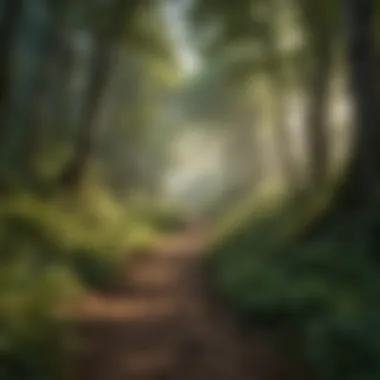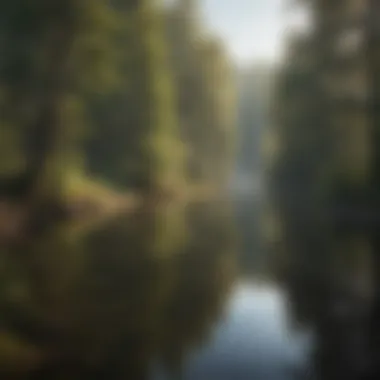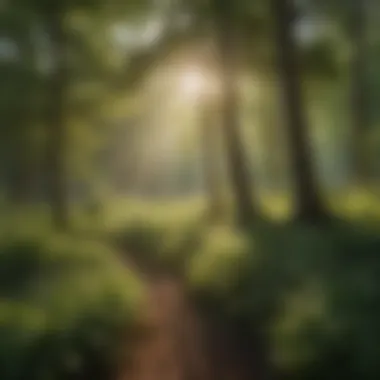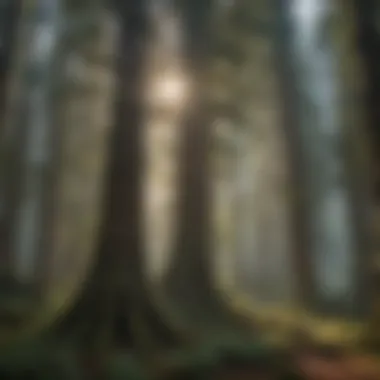Discovering Optimal Woodland Video Production Locations


Intro
Producing videos in woodland environments offers unique opportunities for creative expression. These settings, characterized by their rich biodiversity and serene aesthetics, also highlight the importance of ecological conservation. Understanding the interplay between nature and video production is essential. This article aims to provide insights into selecting optimal locations for videographers that align with environmental stewardship principles.
This guide will address various aspects, from the significance of woodland ecosystems to sustainable forestry practices. By understanding these elements, videographers can enhance their content while advocating for the preservation of these essential habitats.
Understanding Woodland Ecosystems
Woodland ecosystems are complex and dynamic. They support a diverse range of flora and fauna, contributing significantly to global biodiversity. Here, we delve into two primary aspects: the importance of biodiversity in forests and the role forests play in climate regulation.
Importance of Biodiversity in Forests
Biodiversity refers to the variety of life in a particular habitat. Within woodland environments, this diversity is crucial for several reasons:
- Ecosystem Stability: Diverse species can contribute to greater ecosystem resilience. This means that healthy woodland environments are better able to withstand changes such as climate fluctuations or pest invasions.
- Cultural Significance: Many cultures have deep connections to forests, relying on them for sustenance, spirituality, and traditional practices.
- Economic Value: Forests provide resources like timber and non-timber products, contributing to local economies.
Role of Forests in Climate Regulation
Forests act as vital carbon sinks. They absorb carbon dioxide during photosynthesis, playing an important role in mitigating climate change. Additionally, they influence local climates by regulating temperature and humidity. A video production in such ecosystems can showcase this dynamic role, making it a platform for environmental education and awareness.
Sustainable Forestry Practices
To produce quality video content that respects woodland environments, understanding sustainable forestry practices is imperative.
Principles of Sustainable Forestry
Sustainable forestry encompasses a range of practices aimed at managing forest resources without compromising ecological health. Key principles include:
- Minimal Disturbance: Reducing the impact on natural habitats when conducting timber harvests.
- Selective Harvesting: Rather than clear-cutting, removing only certain trees to sustain forest structure and biodiversity.
- Wildlife Protection: Ensuring that crucial habitats for various species are preserved.
Case Studies of Successful Implementations
To better illustrate sustainable practices, consider the example of the sustainable management initiatives in Scandinavia. Countries like Sweden have implemented policies that promote responsible harvesting and conservation methods. These strategies offer models for video producers to learn from, integrating sustainability into their projects.
Woodland Stewardship Techniques
Videographers can contribute by embracing woodland stewardship techniques that focus on the long-term health of forests. This section will explore forest management plans and conservation strategies.
Forest Management Plans
A well-crafted forest management plan governs the use and stewardship of woodland areas. Key elements may include:
- Inventory and Assessment: Understanding the current health and diversity of forest resources.
- Long-term Objectives: Establishing clear goals for sustainable use and conservation of the area.
- Monitoring and Evaluation: Regular assessments to ensure the health of the forest ecosystem.
Conservation Strategies
Conservation strategies can include various actions such as:
- Restoration Projects: Efforts to restore degraded woodland areas can visibly enhance video production settings.
- Community Engagement: Involving local communities can amplify the impact of conservation efforts. Their direct connection to the land often brings invaluable insights and support.
Engaging in woodland stewardship not only benefits ecosystems but also enriches the videography narrative.
In summary, this exploration into woodland environments demonstrates their value as both a backdrop for video production and a crucial ecological asset. With a commitment to understanding and implementing sustainable practices, videographers can play a pivotal role in promoting both creativity and environmental consciousness.
Foreword to Video Production in Woodlands
Video production in woodland environments is an intricate craft that blends creativity with ecological consciousness. Filming in these natural settings offers unique benefits, including captivating visual landscapes and the ability to tell meaningful stories. As videographers seek new locations to enhance their projects, understanding the context of woodland environments becomes important. This section aims to outline the significance and nuances of video production in woodlands, preparing the reader for a deeper exploration.
Defining the Context of Video Production
To appreciate the full potential of woodland videography, one must first understand the context in which it operates. Woodlands are complex ecosystems, housing diverse flora and fauna. This ecological diversity presents videographers with both opportunities and challenges. Equipment may need to be adapted for varying light conditions, weather patterns, and the need for noise reduction to capture the sounds of nature. Recognizing these factors is crucial for successful video production. The production team must also consider the ethical implications of filming in these sensitive environments.
Woodlands can vary greatly in condition and accessibility. Some areas are thriving ecosystems, while others may show signs of degradation. Before selecting a location, videographers should investigate the local biodiversity, land management practices, and prevailing environmental policies to ensure compliance and respect for nature. This foundational knowledge helps guide decisions on where and how to capture footage effectively.
Significance of Natural Settings in Videography


Natural settings are significant in videography, impacting both aesthetic quality and audience engagement. The interplay of light filtering through trees, the sounds of wildlife, and expansive landscapes can convey messages that resonate on a profound level. More than mere backdrops, these environments allow for storytelling that emphasizes the beauty and fragility of nature.
Shooting in woodlands encourages a deeper connection with the audience. Viewers are often drawn to the cinematic qualities of these settings. For instance, dynamic scenery, such as a sun-dappled grove or a flowing stream, enhances visual narratives. This aesthetic appeal aligns with the growing trend of environmental awareness, compelling audiences to reflect on their relationship with nature.
In summary, video production in woodland environments is not just about capturing beautiful footage. It is an opportunity to advocate for conservation and responsible engagement with our planet. As filmmakers navigate the intricacies of these spaces, they can become voices for the ecosystems they represent.
Identifying Ideal Woodland Locations
Identifying ideal locations for video production in woodlands is crucial for enhancing the storytelling aspects of video content. The location chosen can make substantial impact on the overall aesthetic and thematic elements of the production. Factors such as accessibility, natural beauty, and biodiversity are indispensable when selecting a site. These factors not only influence the logistics of a shoot but also shape the visual narrative that connects with viewers. The right woodland setting serves as more than a backdrop; it enriches the content, informs the audience, and engages their appreciation for natural environments.
Criteria for Selection
Accessibility and Proximity
Accessibility and proximity are fundamental elements in selecting a suitable filming location in woodlands. These characteristics ensure that videographers can access their chosen sites without excessive effort or resources. A key advantage is the ease of transporting equipment and crew, which can significantly affect the efficiency of the shooting process. Moreover, proximity to urban areas often means accessible amenities such as lodging and food services. However, a potential drawback is that easily accessible sites may attract crowds, potentially disrupting the filming process. The ideal balance is selecting a location that provides both access and a degree of seclusion.
Visual Appeal and Natural Light
Visual appeal, combined with the availability of natural light, is another critical aspect in choosing woodland filming locations. The aesthetics of a setting can drastically elevate the quality of video production. Locations with ample natural light allow for dynamic shots and reduce reliance on artificial lighting, which is beneficial for outdoor filming. A particular feature of this aspect is the interplay of light and shadow found within woodlands, which can create visually captivating scenes. However, changing light conditions throughout the day can present challenges, requiring filmmakers to adapt quickly to achieve desired effects.
Ecological Diversity
Ecological diversity plays a significant role in enhancing video content by adding layers of interest to the visual narrative. Filming in locations that boast diverse flora and fauna enriches the storytelling, providing visual variety that captivates the audience. Furthermore, such environments often highlight interconnections within ecosystems, raising awareness of their importance. A notable challenge arises, however, as locations with rich ecological diversity may also have specific management guidelines and restrictions, which need to be understood and adhered to during production.
Common Viewpoints
Forest Clearings
Forest clearings offer unique opportunities for video production. They provide open spaces surrounded by dense foliage, making them ideal for capturing a variety of shots without the obstruction of trees. This setting is popular for its balance of openness and natural framing, allowing filmmakers to create striking visual compositions. A potential disadvantage could be the lack of shade in clearings, which might lead to issues with lighting during midday shoots.
Water Bodies within Woodlands
Water bodies, such as streams or ponds, within woodland environments serve as an excellent filming backdrop. They reflect surrounding landscapes beautifully, adding depth and interest to visuals. The calming sounds of water can enhance the atmosphere of the content being created. However, considerations about water accessibility can arise; filmmakers must be mindful of potential legal restrictions and environmental concerns regarding filming near these bodies.
Elevated Areas with Scenic Overviews
Elevated areas provide breathtaking views that can transform ordinary footage into something exceptional. Filming from these vantage points allows for sweeping shots of the landscape, giving viewers a sense of scale and beauty. This height can create dramatic perspectives not easily attainable from the forest floor. Nevertheless, elevation might require additional equipment and safety measures, potentially complicating the shooting process.
Technical Considerations for Video Shooting
When undertaking video production in woodland environments, the technical aspects are vital for achieving high-quality results. Understanding different shooting techniques and equipment needs can enhance the final output while ensuring the content effectively showcases the unique features of these natural settings. Videographers should be aware of not only the tools they need but also how to use them effectively in varying woodland conditions. This foundation can significantly impact the story being told through the visuals.
Equipment Requirements
Cameras and Lenses
The type of cameras and lenses selected plays a crucial role in capturing the essence of woodland videography. DSLRs, mirrorless cameras, and dedicated camcorders each offer unique benefits. A key characteristic of these cameras is their capability to produce high-resolution images with excellent detail, particularly in natural light conditions found in wooded areas. For many videographers, using a wide-angle lens is a popular choice because it allows for capturing expansive landscapes and intricate forest details.
However, one must consider the weight of the equipment when shooting in uneven and often rugged terrain, as this can affect mobility and duration of shooting. Lenses with image stabilization can help reduce shakes caused by movement, making them particularly helpful in this context.
Tripods and Stabilizers
Stability is fundamental to quality videography. Tripods and stabilizers provide the assistance needed to avoid shaky footage, especially when shooting in challenging conditions. A robust tripod can handle the weight of cameras and lenses while providing a solid base for capturing smooth panning shots. The unique feature of stabilizers, such as gimbals, is their ability to allow fluid movement even during walks or uneven surface traversal. Opting for both a tripod and a stabilizer can ensure high production quality in various woodland environments.
However, weight could be a trade-off when choosing stabilization tools. While effective, gimbals tend to add extra weight, which can be cumbersome in thick forests.
Audio Recording Tools
In videography, audio is as crucial as visuals. Professional audio recording tools contribute significantly to the overall impact of woodland videos. Good choices include shotgun mics and portable recorders that allow for high-quality audio capture without excessive background noise. The distinctive feature of shotgun microphones is their directionality, essential when one wants to focus on specific natural sounds without distractions from other sounds.
These tools should be portable and lightweight, allowing for flexibility during video shoots. As some woodland areas are quieter than others, utilizing high-quality audio tools can enhance the overall storytelling experience, making it more immersive for the audience.
Optimal Time for Filming
Timing can significantly influence the quality of video production in woodlands. Natural light varies throughout the day and seasons, impacting both visibility and mood of the footage. Understanding the best times for filming can make a difference in how the material is perceived.
Best Hours for Natural Lighting


Filming during the golden hours — just after sunrise and before sunset — can yield beautiful lighting conditions, enhancing the natural beauty of woodland environments. These times produce soft, diffused light that minimizes harsh shadows and highlights. It contributes to a visually pleasing aesthetic which elevates the overall quality of the video.
However, one needs to plan shooting schedules meticulously around these hours due to their limited duration. Preparing ahead can help mitigate missing these optimal times.
Seasonal Considerations
Seasons dictate the appearance and accessibility of woodland areas. Spring might display vibrant blooms, while fall showcases rich colors from changing leaves. Each season possesses its unique characteristics, affecting how a location may be filmed. Seasonal variety can also impact wildlife behavior, providing diverse opportunities for capturing unique footage.
However, adverse weather conditions during certain seasons can limit access and equipment performance. Understanding these nuances helps videographers prepare adequately, ensuring that they can still achieve their desired visuals under changing circumstances.
Potential Woodland Locations
The selection of appropriate settings for video production in woodlands is essential for enhancing visual storytelling. Key considerations include access to each site and the inherent beauty of these locations. Furthermore, the ecological richness of woodlands adds depth to video content. By identifying potential woodland locations, videographers can create compelling narratives that resonate with audiences. These landscapes have unique characteristics that can significantly impact the message conveyed through the lens.
State and National Parks
Overview of Popular Parks
State and national parks often emerge as premier locations for videographers. These parks offer diverse landscapes, from towering pine trees to tranquil lakes. The natural environment provides a backdrop that enhances the aesthetic quality of any film project. Notable parks such as Yosemite National Park or Yellowstone serve as inspiration for many. Their expansive setups allow for versatile shooting options, capturing both macro and micro aspects of nature. However, the scale and popularity can also mean crowds, which may hinder filming efficiency.
Permitting and Logging Guidelines
Permitting is a critical aspect when filming in state or national parks. Each park has specific regulations that videographers must adhere to, including the need for permits for commercial shoots. Understanding these regulations enhances planning and resource allocation. The cost and time associated with obtaining necessary permits can be significant. Planning ahead is vital to avoid unexpected challenges. Following these guidelines maintains the integrity of natural spaces while promoting responsible film production.
Nature Reserves
Benefits of Shooting in Protected Areas
Nature reserves offer protected environments that significantly benefit video production. These areas often feature native flora and fauna, presenting rare subjects for filmmakers. Shooting in a nature reserve can ensure the preservation of these habitats by raising awareness about biodiversity. Videographers can capture unique footage that might not be available elsewhere. However, restrictions might apply, so understanding the rules is critical to success.
Conservation Considerations
Conservation is a primary focus in nature reserves. Understanding and respecting these principles contributes to responsible videography. It is important to be aware of the impact cameras can have on sensitive ecosystems. Planning shoots that minimize physical disturbance is essential. Highlighting conservation efforts in videos can also provide educational value, creating a link between storytelling and environmental responsibility.
Urban Woodlands
How Urban Green Spaces Fit
Urban woodlands offer a bridge between nature and human settings. These green areas can be rich with biodiversity and provide unique filming opportunities. Urban parks are often accessible and offer convenient locations for videography. Finding the right balance within the urban environment can make a significant difference. However, ambient noise and human activity might detract from the natural feel in videos.
Balance Between Nature and Cityscapes
Shooting in urban woodlands allows for interesting contrasts. This juxtaposition provides profound commentary on urbanization's impact on nature. Highlighting the coexistence of city life and natural elements can enhance storytelling. Understanding how to capture this balance is key, as it illustrates complex themes. However, it requires skill to ensure that neither element overpowers the other visually.
Promoting Woodland Conservation through Videography
Promoting woodland conservation through videography is an essential aspect of modern video production in natural settings. Videographers have a unique opportunity to enhance awareness about the importance of woodlands and their ecosystems. By capturing the beauty and intricacies of these environments, videos can serve as powerful tools to inform and inspire action toward conservation efforts. This section explores how videography can intertwine with environmental stewardship while offering practical insights for creators.
Environmental Storytelling
Showcasing Ecosystem Services
Showcasing ecosystem services is vital in understanding the roles that woodlands play in our environment. Ecosystem services encompass benefits such as air purification, carbon sequestration, and water regulation. By focusing on these elements in their videos, creators can highlight the utility and need for preserving these areas.
This aspect is particularly beneficial as it paints a clear picture of the functional value of woodlands. The key characteristic of showcasing ecosystem services is a focus on tangible benefits that people rely on daily.
Unique features of this approach are its ability to educate viewers about the often-overlooked contributions of forests to human well-being. However, deciding how to visually represent these services can be challenging. The representation needs to be accurate and relatable while avoiding overly scientific jargon that may alienate the audience.
Highlighting Indigenous Practices
Highlighting indigenous practices brings to light the traditions and knowledge of local communities that live symbiotically with woodland environments. This approach emphasizes cultural respect and the wisdom passed down through generations regarding land management. It is a powerful tool for demonstrating sustainable practices, showcasing an understanding of the land that modern methods may overlook.
The benefit of including these practices in videos is that it fosters an appreciation for diverse ecological philosophies. This highlights the importance of sustainability and resilience.
However, one potential downside is the risk of tokenism. Videographers must ensure that indigenous representation is authentic and not superficial. Collaboration with indigenous people is essential to avoid misrepresentation.
Engaging the Audience
Informative Narratives
Informative narratives are a crucial aspect of engaging the audience. They provide context to the visual elements of woodland videography. These narratives can illuminate the biodiversity within woodlands and the threats they face, creating a more immersive experience for viewers.
The key characteristic of informative narratives is that they deliver structured information in a way that is both engaging and educational. This is beneficial as it provides clarity and enhances the viewer's understanding of complex ecological relationships.


However, the challenge lies in balancing information with captivating storytelling. Too much information can overwhelm viewers, while too little can fail to convey the necessary urgency for conservation efforts.
Calls to Action for Preservation
Calls to action for preservation transform viewer engagement into tangible outcomes. These components motivate audiences to participate in conservation efforts, whether through advocacy, volunteering, or donations. Including a strong call to action in videos can significantly impact audience behavior.
The unique feature of this approach is its ability to provoke emotional responses, prompting individuals to act. The key characteristic is that it goes beyond simply informing; it inspires a sense of duty to protect woodland environments.
On the downside, overly aggressive calls to action can lead to viewer fatigue or resentment. It is vital to present these calls in a way that feels inclusive and supportive rather than demanding or out of touch with viewers' capabilities.
"Videography is not just about telling a story; it is about forging connections with nature and empowering others to join the conservation effort."
Through these focused efforts, videographers can significantly contribute to woodland conservation. By using the medium to educate, engage, and inspire action, they can strengthen the bond between people and nature.
Challenges in Woodland Videography
Understanding the challenges in woodland videography is essential to create impactful and authentic visual narratives. The complexities of the environment can affect the quality of the video content and the overall production process. It is crucial for videographers to anticipate these challenges to navigate them effectively and ensure that the shoot aligns with the intended vision.
Environmental Factors
Environmental factors are a significant aspect of woodland videography and can contribute substantially to the success or failure of a project.
Weather Variability
Weather variability presents both opportunities and challenges during filming in woodland settings. For instance, changing weather conditions—such as rain, fog, or unexpected sunshine—can drastically alter the lighting and mood of a scene. This unpredictability can be both a benefit and a hindrance.
A key characteristic of weather variability is its effect on natural light. Natural light can highlight textures and colors in a woodland setting, making the visuals stunning. However, it also demands flexibility in planning. Videographers must be prepared to adjust schedules or change shooting techniques based on current conditions. The unique feature of weather variability is its dynamic nature; it can create atmospheric feelings that static conditions cannot.
However, it may disrupt or delay shoots, which can lead to a need for additional time and resources. Being ready to adapt is a necessary trait for woodland videographers.
Wildlife Interference
Wildlife interference is another common challenge faced in woodland videography. This can occur when animals instinctually react to the presence of humans or equipment. It’s important to recognize that wildlife adds both context and authenticity to a woodland narrative. The presence of animals can bring life to the frame, but it can also present issues.
A major characteristic of wildlife interference is the potential for unpredictability. Animals may move off set, make sounds, or intrude just as a shot is being taken. This interference can take time away from shooting. A unique aspect of wildlife interference in woodland settings is the need for patience and silence, which contrasts with the often fast-paced nature of videography.
While capturing wildlife can enhance the story being told, it is often at odds with the need for controlled shooting conditions. Thus, this challenge requires videographers to balance the spontaneity of wildlife with the structured demands of video production.
Legal and Ethical Considerations
Navigating legal and ethical considerations is paramount in woodland videography. There can be numerous restrictions and guidelines that govern filming in these environments.
Understanding Permissions
Understanding permissions is a critical aspect of shooting in woodland settings. Many natural areas are protected by various laws, which require permits to film. Videographers must research and secure necessary permissions as a crucial first step.
The key characteristic here is the legal obligation to respect regulations that may be in place. These regulations exist to protect both the environment and the species within the ecosystem. The unique feature regarding permissions is their diversity; different areas may have different rules and structures governing filming activities. Securing the proper permits can take time and should be considered in the planning phase of production.
Failure to obtain the necessary permissions can lead to fines or the cancellation of shoots, which could waste valuable resources and time.
Respecting Natural Habitats
Respecting natural habitats is a fundamental ethical principle in woodland videography. This consideration emphasizes the need to preserve ecological integrity when filming. The key characteristic of this respect is that it requires videographers to be mindful of their impact on the environment.
A unique feature of respecting natural habitats is its reciprocal relationship with good videography. When the habitat is respected, the natural beauty and integrity of the space can enhance the narrative being captured. However, ignorance to local flora and fauna can lead to disturbances that harm wildlife or disrupt ecosystems. This can tarnish the ethical credibility of the videographer and undermine the project itself.
Closure
The conclusion draws several threads together regarding the importance of video production in woodland environments. This article has provided a comprehensive examination of various woodland locations, technical considerations, and the challenges inherent in capturing nature on film.
Video production in these settings is not merely an artistic pursuit; it is also an opportunity to engage audiences with the wonders of nature. By using visual storytelling, videographers can raise awareness about environmental issues and the beauty of forest ecosystems. The settings discussed serve not just as backdrops, but as essential components in conveying the narrative of conservation and environmental stewardship.
Reflection on the Role of Video Production
The role of video production in woodland areas transcends visual aesthetics. It enables creatives to document and share the significance of natural spaces. Each film or video clip possesses the potential to evoke emotions and inspire action. The choice of location influences the narrative conveyed.
In filming, the interconnectedness of humanity and nature becomes evident. By selecting specific locations, videographers can demonstrate how humans impact woodlands while emphasizing the need for sustainable interaction with these ecosystems. Furthermore, projects that highlight local flora and fauna can ground viewers in the realities of ecological balance and conservation efforts.
Future Perspectives for Woodland Videography
Looking ahead, the future of woodland videography holds immense potential. As technology progresses, tools like drones and advanced stabilization equipment will enhance the filming process. These advancements will allow for more dynamic shots and perspectives that were previously unattainable.
Moreover, as interest in environmental issues continues to grow, so does the audience for nature-focused content. Filmmakers have a unique position not just to entertain but to inform and inspire. Future projects may increasingly focus on collaboration with conservation organizations, aiding the promotion of initiatives aimed at preserving woodland habitats.







